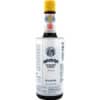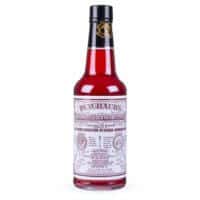If you are experienced with cocktails, you are most likely acquainted with bitters as well. Many people use them to spice up the recipe. On the other hand, some prefer to drink bitters straight or on the rocks. In this article, we’ll investigate what are bitters, how are they used, what are the most prominent types and varieties, and what are they made of.
First Up: What Are Bitters?
Many people ask us, "what are bitters?" Bitters are alcohol-based preparations which use herbs, fruit, or other ingredients of botanical origin for flavor. The two main types include cocktail and digestive bitters.
Cocktail bitters typically feature a high percentage of alcohol and are packed in small bottles. They usually taste bittersweet, sour, or bitter. As their name suggests, they are predominantly used in cocktails, though they can also be added to food (mostly desserts).
Digestive bitters have lower alcohol content and are often consumed as regular alcoholic beverages.
Some of the most popular ingredients include roots, aromatic herbs, seeds, spices, fruits, and bark. Today, it is not unusual to find cocktail (concentrated) bitters infused with artificial sweeteners or colorants.
History
Bitters are by no means a modern invention. In some form or another, they’ve been around for centuries. Their existence can be traced all the way to ancient Egypt where medicinal herbs were supposedly added to wine at the time.
The next major step in the development of bitters occurred in Europe during the medieval period. That’s when herbal bitters began to emerge as highly concentrated concoctions used for medicinal purposes.
Finally, the 19th century saw the bitters evolve into its modern form and gain widespread popularity (especially in Britain and across British colonies). That’s also when two of the most prominent brands of cocktail bitters – Peychaud’s Bitters and Angostura – were created.
Peychaud’s Bitters
Antoine Peychaud started making Peychaud’s Bitters in New Orleans around 1830. Peychaud was an apothecary and a native of Saint-Domingue (the French colony now known as Haiti) who relocated to New Orleans in 1795.
These bitters are based on gentian herbs, similar to the other popular brand – Angostura bitters. However, the Peychaud variety has a prominent anise and mint aroma. Today, these bitters are made and sold by Sazerac Company and most prominently used in the Sazerac cocktail.
Click here | Peychaud's Bitters on Amazon
Angostura Bitters

Originally, bitters were used to treat stomach problems in soldiers of the Bolivarian army, though it later became a popular addition to cocktails.
The brand is now owned by Trinidad and Tobago-based House of Angostura company. The recipe is a company secret. Only one person knows the full recipe, which is passed on by heredity.
Bitters are prominently used in cocktails, most commonly mixed with gin, vodka, and whiskey. They are frequently found in the Old Fashioned, Mojito, Manhattan, Pisco Sour, the Hong Kong variety of the Gunner cocktail, long vodka, and others.
One of the misconceptions is that bitters contain angostura bark which makes it… poisonous. However, neither is true.
Click Here | Angostura Bitters on Amazon
Other Prominent Varieties
Back in the 19th century, orange bitters made from Seville oranges and a range of spices were among the prominent varieties. However, they fell out of fashion over time.
Another historically significant type of bitters is the quinine-infused tree bark variety. This type of bitters was often prescribed to malaria patients. Aside from the medical use, quinine-infused bitters were also prominently used in old cocktail recipes.
The best way to learn about bitters is to mix up a great cocktail. We have an excellent red wine cocktail that features orange bitters. Give it a try!
Digestive Bitters
Digestive bitters are the other major group of bitters. They usually contain lower alcohol content than concentrated cocktail bitters and are often consumed after a meal (at least in South America and Europe). Typically, digestive bitters are commonly consumed with ice or neat. The most popular types include Kräuter (German) and amaro (Italian).
Many popular digestive bitters are commonly used as cocktail ingredients as well. The most popular brands include Campari, Jägermeister, Amaro Montenegro, Amaro Lucano, St. Vitus, Ramazzotti, Jeppson’s, Suze, and others.
Home-Made Bitters
If you’d like to take a shot at making your own cocktail bitters, here’s how the general process works. First, select your combination of herbs, fruits, nuts, bark, and other flavor ingredients. Next, pick a high-proof, neutral-tasting spirit, such as whiskey or vodka. Put all ingredients into an airtight jar. Store the jar in a dark and cool place. Shake the jar every day to help it blend quicker. When it’s done, strain your bitters through a cheesecloth. Have in mind that some combinations of the ingredients might take as long as a whole month to properly blend.
Conclusion
We hope this article answered the question, "what are bitter?" and gave you a good idea of which bitters to buy. Concentrated bitters are key ingredients of many famous cocktails, while some of the digestive bitters are popular drinks in their own right. Whichever type you decide to explore, get ready for an exciting journey and a whole new range of tastes.
